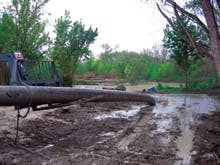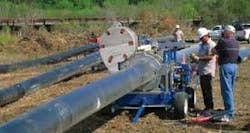Water and the City of Corsicana, TX, have an interesting past. Corsicana, located about 50 miles south of Dallas, is where oil was first discovered west of the Mississippi River. In 1884, the city hired a water well driller. But instead of hitting water, oil spurted from the well. The city fathers were so unhappy they refused to pay the contractor. Soon after, Corsicana became the first Texas oil boomtown.
Water and Corsicana have had an interesting 2007, as well. Early in the year, the city leaders had a serious reason to be unhappy with the water situation - they were running out of it. By early summer, however, heavy rains flooded Texas, taking the region’s water crisis to the opposite extreme.
The city’s two water sources are Navarro Mills Lake, a reservoir southwest of the city, and Lake Halbert, a small reservoir near the water treatment plant. As of today, those sources are adequately supplied. But earlier this year, that was anything but the case. Before the rains came, the Navarro Mills water level had dropped more than eight feet from normal levels, three feet below “Moderate - restricted use” levels and less than two feet from “Severe - no outdoor water use” levels.
In October 2006, the drought had surpassed the year-and-a-half mark and city officials were forced to figure out a way to get water to the 25,000 residents - and fast. The answer was to pipe the water from the still-plentiful Richland-Chambers Reservoir, southeast of the city.
And because of its immediate availability and low total cost of installation, smoothwall high-density polyethylene (HDPE) pipe was chosen for the emergency pipeline.
“Due to the railroad lines and the restricted right-of-ways on this project, HDPE was really the only pipe that could be used for this project,” said Corsicana Environmental Services Manager Larry Murray. “We had just three or four feet around the pipeline to work with. Other pipes would have needed much bigger right-of-ways for the trucks, welders, etc.”
Murray added that the HDPE pipe has a high recoverable market value if they should ever decide to sell it when the emergency line is no longer needed. But even better, the pipe could be reused for another pipe project elsewhere in the city. A permanent line will be installed after October 2008. Plans for what to do with the current pipeline and a timeline for the permanent system have not yet been made.
The temporary line remains in place and will be ready to again provide water if the drought conditions in Texas return before late next year.
Since Corsicana has some water rights to the water in Richland Chambers, the city struck a deal with Tarrant County Water District (TCWD) to tap into the district’s transmission line to supply water to Lake Halbert due to the drought conditions.
The 16-inch polyethylene line ran from the TCWD transmission line to an existing city line leading to Lake Halbert. The line was mostly laid above grade with five directional bores - two under highways, two under county roads, and one creek crossing.
During the drought, the line was delivering four million gallons of water per day to the city, which met about half of the community’s daily needs.
“When we got the call, we were told the city was about three weeks away from the severe drought category,” said Tom Fraser of Fraser Mining, a member of the Plastics Pipe Institute (PPI), a trade association headquartered in Irving, TX. “We were able to install an average of about 2,500 feet of pipe per day.”
The job was started on October 2, 2006, and completed on October 18. About 26,000 linear feet of pipe was installed using a four-man crew and three fusion machines. Fusion joining creates a leak-free, monolithic pipe string and also eliminates the need for restraining devices on joints and fittings.
“With the purpose of this project being to deliver water to a drought-stricken community, any water leak would be totally unacceptable,” Fraser said.
Fraser said the biggest challenges were maneuvering through the lower areas of a flood plain, the creek crossings and the underground borings. The shortage of time and the shortage of right-of-ways meant that cooperation with the city was crucial.
“The city had used PE pipe in directional drilling and pipe bursting projects in the past,” Fraser said. “Because it’s a temporary line, we knew most of the line would be above grade.
“But since the joints were leak free, and the pipe itself is black, we were not worried about leaks or UV degradation. And the flexibility of the pipe lends itself perfectly to the underground installation sections.”
Corsicana project manager Jerry Yeats of Fraser Mining used directional drilling techniques to make the 250-foot creek crossing from Richland-Chambers to Lake Halbert.
“HDPE makes it easy to pull a sleeve for your underground bores then pull the pipe right through that,” Yeats said. “In environmentally sensitive areas, this installation technique is the best thing going. Plus, we didn’t know exactly what ‘temporary’ meant, so we needed a pipe that would last a long time and not be susceptible to corrosion.”
With applications such as the one in Corsicana in mind, PPI has recently published a comprehensive handbook to assist designers, contractors and owners in designing and installing HDPE piping applications. While directional drilling itself is not a new concept, specific considerations such as pullback force capability, collapse resistance and long-term performance of the PE pipe once it’s installed in the bore-hole are explained.
“Polyethylene pipe is ideally suited for these demanding installations because of its continuous, jointless fused system and because of its flexibility, corrosion resistance and seismic resistance,” said Camille George Rubeiz, P.E., director of engineering at PPI.
Other topics in the hardbound Handbook of PE Pipe include:
- Design, including pressure and flow capacity, buried pipe design and thermal considerations
- Engineering properties
- PE pipe and fittings manufacturing
- Specifications, test methods and codes>
- Joining procedures
- Marine installations
- Pipeline rehab by Sliplining
The PPI Handbook of PE Pipe is available for purchase at the PPI’s website, www.plasticpipe.org, and can also be downloaded in PDF format for free.





